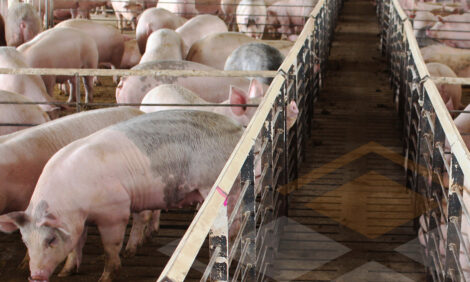



Rates of Swine Flu Findings Higher in Younger Pigs
Influenza A viruses (IAVs) are distributed worldwide in birds, pigs and humans, and cause important endemic disease affecting hosts in all countries. This study from Andres Diaz and colleagues published in PLOS One aimed to find out more about the epidemiology of the disease, to help devise more effective control measures in future.The segmented genome of IAVs allows the exchange of gene segments between IAVs during infection and replication facilitating the emergence of novel IAV reassortants with pandemic potential. The 2009 pandemic IAV contained genes from swine IAVs circulating in North America and Eurasia and highlighted the importance of pigs in the ecology of IAVs among species.
Influenza-like disease was first reported in pigs in 1918 at the time of the human Spanish flu pandemic and the virus was first isolated from pigs in 1930. Currently, IAV infections occur worldwide and are considered endemic in swine populations.
In the US, IAVs have been present in pigs for many decades and several serological surveys conducted since the 1970’s have consistently demonstrated that IAVs are ubiquitous in swine. IAVs remained genetically stable in pigs in the US with minimal or undetected viral evolution until 1998 when H3N2 reassortant viruses of swine, human and avian origin were detected in pigs.
Subsequently new strains, new subtypes, and multiple reassortant viruses have been identified in pigs in North America.
There is evidence that multiple human introductions of IAVs, including the 2009 H1N1 pandemic virus, into the pool of IAVs circulating in the US have greatly contributed to the increase of genetic diversity of the virus. The contemporary swine farming methods and live animal movements between farms and geographical regions increase IAV diversity and make IAVs harder to control in swine populations.
However, limited information is available about the frequency of IAV introduction and its maintenance within swine herds.
IAV infections are common in the US Midwest, and herds can test positive year around with diverse viruses, regardless of the presence or absence of clinical signs and vaccination status.
Although influenza infections in individual pigs are of short duration (5–7 days), IAV infections of herds can be prolonged (weeks or months). When population dynamics, and extended IAVs circulation in pig farms are taken in consideration, the likelihood of reassortment increases.
Furthermore the introduction of IAV strains of human origin broadens virus diversity in pigs and this diversity is accentuated by the frequent movement of weaned pigs into swine-dense areas.
The contemporary US swine industry is mostly organized into multi-site production systems. These systems have defined production stage facilities located in different geographical sites.
Breeding, gestation and farrowing takes place in breed-to-wean (breeding) herds. At approximately 21 days of age, piglets are weaned and transported to a nursery or a wean-to-finish site where pigs are raised until 10 weeks of age or to market-age respectively.
Breeding herds house replacement animals (gilts), adult females (sows), and piglets. Except on breeding farms where farrowing occurs in batches, typically piglets are born daily, with weekly births totaling about 40 per cent of the resident adult female population.
Adult females are replaced at a yearly rate of 45 to 55 per cent, and replacement gilts are regularly introduced on schedules that range from 1 to 10 weeks across farms. As a result, breeding populations have high rates of turnover, and associated fluctuations in herd’s susceptibility to IAV infections.
Previous studies have shown that it is not easy to recover IAVs from sows. However, the dynamics of IAV infection among other subpopulations (gilts and suckling piglets) may influence the maintenance of IAVs in the breeding herd or contribute to the emergence of novel strains.
In the present study, the authors aimed to define patterns of IAV infection in the most labile subpopulations on 5 IAV-infected breeding farms in the Midwestern USA, with the goal of understanding the relative importance of these subpopulations as sources of new IAV infections in the breeding herd.
Although pigs play a key role in the ecology of IAVs, the epidemiology of IAVs within swine herds is poorly understood.
This information is necessary to design targeted strategies to control IAV infection within and between swine herds, and to minimize the risk of IAV infections of swine origin to people.
Each herd was sampled monthly for a year and, at each visit, 30 individual nasal swabs were collected from the three subpopulations, namely:
- replacement females, resident on-farm for less than 4 weeks (new gilts),
- replacement females, resident on-farm for more than 4 weeks (gilts),
- neonatal pigs less than 21 days of age (piglets).
Real time reverse transcriptase polymerase chain reaction (RRT-PCR) was used to detect IAVs, and the association between IAVs infection and pig subpopulation was measured using a mixed logistic regression model.
Nasal swabs (n = 4,190) were collected from 141 groups of pigs. At least, one IAV-positive nasal swab was found in 19.9 per cent (n = 28) of the sampled groups, and 7.7 per cent (n = 324) of all nasal swabs tested positive.
After adjusting by annual quarter and sampling event, the odds of testing IAV positive were 7.9 (95 per cent CI 1.4, 43.9) and 4.4 (95 per cent CI 1.1, 17.1) times higher in groups of new gilts and piglets compared to groups of gilts, respectively.
Results indicate that new gilts and piglets had higher odds of testing IAV positive than gilts in swine breeding herds and that season influences IAV infection in pigs.
Based on these findings, we recommend that IAV control strategies be aimed at preventing infection before gilts are introduced into the farm, and in pigs prior to weaning.
August 2015






